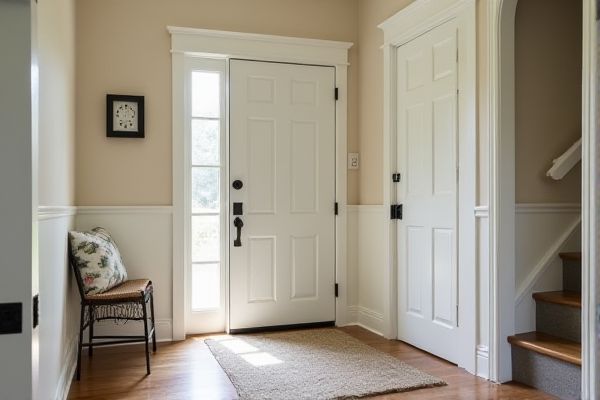
Poplar trim offers natural wood grain and superior durability for mudrooms, ideal for withstanding moisture and wear, while MDF trim provides a smooth, cost-effective alternative that resists warping but may be less durable over time. Explore this article to discover which trim best suits your mudroom's needs and aesthetic preferences.
Table of Comparison
| Feature | Poplar Trim | MDF Trim |
|---|---|---|
| Material | Natural hardwood, solid wood | Engineered wood fiber, medium-density fiberboard |
| Durability | Strong, resists dents and wear | Smooth but prone to water damage and swelling |
| Moisture Resistance | Moderate, better with finish | Poor, not recommended for high-moisture areas |
| Appearance | Natural wood grain, paint or stain friendly | Uniform smooth surface, ideal for painting |
| Cost | Higher, premium hardwood pricing | Lower, budget-friendly option |
| Installation | Easier to nail and shape, less dust | Requires careful handling due to fragility |
| Best Use | High-traffic mudrooms, durable trim needs | Low-moisture, budget-conscious projects |
Introduction to Mudroom Trim Choices
Mudroom trim choices play a crucial role in balancing durability and aesthetics, with poplar trim offering a solid wood option known for its smooth finish and paint adherence, while MDF trim provides a cost-effective, moisture-resistant alternative ideal for high-traffic areas. Poplar is favored for its natural wood grain and ability to take stains or paints evenly, making it a popular choice for homeowners seeking a classic look. Your decision between poplar and MDF trim should factor in environmental conditions and budget constraints to ensure long-lasting performance in your mudroom.
Overview of Poplar Trim
Poplar trim in mudrooms offers a durable, lightweight, and paint-ready option, known for its smooth grain and resistance to warping, making it ideal for high-traffic areas. Its natural wood composition allows for easier customization and staining compared to MDF trim, which is denser but less forgiving with moisture. Choosing poplar trim enhances your mudroom's aesthetic with a classic wood finish that withstands daily wear and tear efficiently.
Overview of MDF Trim
MDF trim offers a cost-effective and smooth surface option for mudroom installations, resistant to warping and cracking compared to natural wood like poplar. It provides excellent paint adhesion, ensuring a clean, consistent finish that maintains its appearance over time in high-traffic areas. Your choice of MDF trim can enhance durability and style while minimizing maintenance in a busy mudroom environment.
Durability: Poplar vs MDF in Mudrooms
Poplar trim offers superior durability in mudrooms due to its natural wood strength, resisting dents and scratches better than MDF. MDF trim is prone to swelling and damage in high-moisture environments common in mudrooms, compromising its longevity. Your mudroom benefits from poplar's resilience, ensuring a longer-lasting and low-maintenance finish.
Moisture Resistance Comparison
Poplar trim in your mudroom offers natural moisture resistance due to its hardwood properties, making it less prone to warping compared to MDF trim. MDF trim, composed of compressed wood fibers, tends to absorb moisture more readily, leading to swelling and potential damage in damp environments. Choosing poplar trim ensures greater durability and longevity in high-moisture areas like mudrooms.
Cost Analysis: Poplar Trim vs MDF Trim
Poplar trim for mudrooms typically costs between $1.50 and $3.00 per linear foot, offering a durable, paintable surface that can withstand moisture better than MDF, which ranges from $0.60 to $1.20 per linear foot but is more prone to swelling and damage in humid environments. While MDF trim is more affordable upfront, poplar's superior durability and resistance to warping can reduce long-term maintenance expenses, making it a cost-effective choice for high-traffic mudroom areas. Factoring in labor and longevity, poplar trim provides better value over time despite higher initial costs compared to MDF.
Aesthetic Differences and Customization
Poplar trim offers a natural wood grain and warmth that enhances the aesthetic appeal of a mudroom, making it ideal for those who want a classic or rustic look. MDF trim provides a smooth, uniform surface that is easy to paint and customize, allowing for versatile design options and intricate moldings. Your choice depends on whether you prioritize authentic wood texture or the flexibility of a paint-ready trim that can match any color scheme.
Installation Ease and Techniques
Poplar trim in mudrooms offers easier installation due to its lightweight nature and ability to hold nails firmly, making it ideal for precise cuts and sanding. MDF trim requires careful handling during installation because it is denser and can chip easily, often needing pre-drilling and specialized adhesives to ensure secure fitting. Your choice between poplar and MDF trim will impact installation time and technique, with poplar being more forgiving for DIY projects.
Maintenance and Longevity
Poplar trim in mudrooms offers superior durability and resists dents and scratches better than MDF, making it ideal for high-traffic areas prone to wear. MDF trim requires careful maintenance to avoid moisture damage, as it can swell and deteriorate if exposed to humidity, reducing its lifespan. Proper sealing and periodic repainting extend the longevity of both materials, but poplar generally demands less upkeep and maintains its appearance longer in damp or dirty environments.
Best Trim Material for Your Mudroom
Poplar trim offers superior durability and natural wood grain, making it an excellent choice for high-traffic mudrooms prone to moisture and wear. MDF trim provides a budget-friendly, smooth surface ideal for painted finishes but may not withstand humidity and impact as well as poplar. Your mudroom's environment and desired aesthetic should guide the decision between the long-lasting resilience of poplar or the cost-effective versatility of MDF trim.
 homyna.com
homyna.com